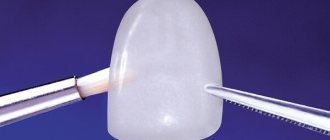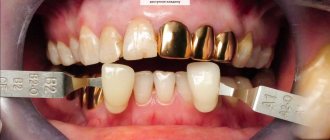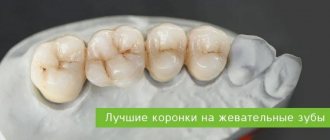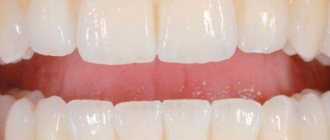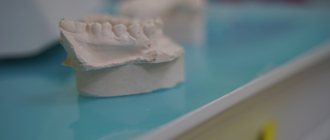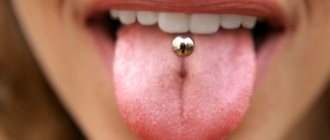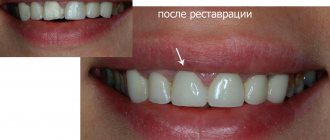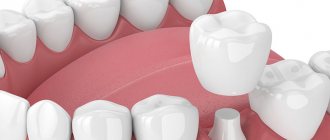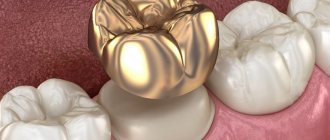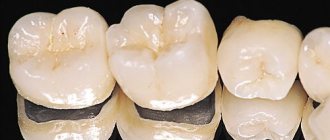Metal-ceramic crowns are the most popular method of dental prosthetics because they have a number of advantages: their appearance is as close as possible to natural, and they can last for many years without signs of wear.
Metal-ceramic prostheses are made in the form of bridges or crowns. Crowns made of this material perfectly replace molars, for which functionality is primarily important.
And although such prostheses are highly durable, they require certain care. Following some simple rules allows you to keep crowns in excellent condition and significantly increases their service life.
Content:
- Features of metal-ceramic crowns per tooth
- The need to install a metal-ceramic crown on a tooth
- The procedure for manufacturing metal-ceramic structures for teeth
- The procedure for installing a metal-ceramic crown on a tooth
- Rules for caring for metal-ceramic crowns
- Repair procedures for metal-ceramic crowns on teeth
A metal-ceramic tooth crown consists of two parts: metal and ceramic, respectively. Unhealthy teeth cause great discomfort and require the help of a specialist. When it is impossible to restore the original shape of teeth for a long time by filling, doctors suggest installing crowns. Metal-ceramic products are the best option for restoring teeth. The first layer is metal, it is responsible for the chewing function; ceramics are thinly applied to it. This coating does not cause allergic reactions, so it is suitable for most patients. The procedure is carried out by highly qualified specialists with experience. The quality of work on installing a crown on a metal-ceramic tooth is ensured by modern equipment and original materials.
Features of metal-ceramic tooth crowns
Such products can serve uninterruptedly for more than ten years; with the correct load during chewing, high-quality installation, and proper care, the period increases.
The manufacture of prostheses requires professional knowledge, materials whose quality is confirmed by a certificate, and laboratory conditions. By observing all the required standards, prosthetics will be completely safe for the client.
Despite the fact that metal-ceramic crowns do not emit toxic substances during use, they can behave in different ways in the mouth, each case is individual. A frame made of nickel or chromium-nickel alloy can cause allergies if the structure is based on a base metal; it will oxidize over time when in contact with saliva.
The high strength of the crowns allows for greater loads when chewing. Due to their aesthetic appearance, the products are often installed to cover the front teeth, as well as premolars and molars.
The metal-ceramic crown is highly durable, does not wear off and is not subject to carious changes.
There are cases of puncture, to eliminate the problem there is no need to remove the product; specialists correct the prosthesis in the oral cavity.
One of the disadvantages is the high degree of grinding of the abutment tooth. Most often, the tooth is depulped and the root canals are filled. In this case, it is necessary to remove the nerve to avoid burns to the pulp.
Making a crown for a tooth from metal-ceramics
Preliminary treatment
Dental treatment is an important point not only before prosthetics or implantation, but throughout life. Timely sanitation of the oral cavity preserves the health and integrity of the dental system, avoids possible complications, as well as the spread of infection throughout the body. Treatment of abutment teeth , hidden and obvious carious cavities, acute inflammatory processes in periodontal tissues or bones is mandatory before starting any prosthetics. This will allow not only to eliminate defects or diseases that have arisen in a timely manner, but also to extend the service life of the prosthesis. Also, some fixed structures require mandatory endodontic treatment.
The need to install a crown on a metal-ceramic tooth
It is advisable to install a metal-ceramic crown to restore a tooth that cannot be restored with filling, for installation on an implant, and also when tooth enamel is highly abrasive. Such prostheses can serve as a replacement for previous metal or plastic ones.
Metal-ceramics restores the natural shape of teeth with high precision and is almost the same in shape and texture. After prosthetics, the patient does not feel discomfort, there are no defects in speech and chewing function. It is practiced to install metal-ceramic dentures on teeth and crowns in the complete absence of dentition. The introduction of crowns is advisable regardless of the type of tooth.
Due to the hygiene and material, the crown is resistant to the influence of pathological microflora, bacteria, and fungi.
In case of abnormalities in the development of the dentition, if inlays or veneers are contraindicated, a crown will be the best option.
During operation, the prosthesis does not change color and is not affected by natural pigments, food coloring, nicotine, caffeine, etc.
Contraindications include:
- allergic reactions to product materials;
- periodontal disease and severe periodontitis;
- malocclusion;
- bruxism;
- low set teeth;
- excessive tooth mobility.
To avoid unwanted reactions and consequences after installing a prosthesis, you must carefully read the contraindications.
Making a crown on a tooth, before and after photos
What is the service life of different types of crowns?
As you know, any structure has a certain service life. Unnecessarily long use can lead to dire consequences.
So: how often should crowns be replaced?
It is believed that the average service life of a crown is 5-7 years. At one time, scientists proved that it is after such a period of time that the cement on which the crown is fixed begins to undergo changes. But this does not mean that the crown must be changed every 5 or 7 years. During this period, a doctor should evaluate it to understand whether it can still serve or whether the crown needs to be replaced.
In addition to the duration of use, during a preventive examination, the doctor evaluates the following parameters: the quality of the marginal fit of the crown to the tooth, the condition of the gums and bone tissue next to the crown, X-ray data of the tooth, patient complaints, etc.
The procedure for making crown structures for teeth made of metal-ceramics
- Before proceeding with crown modeling, the client is prescribed a series of laboratory examinations. To install a prosthesis, the patient's oral cavity must be completely healthy. Found open cavities are filled and professional cleaning is prescribed.
- Based on the results of the preparatory period, you can begin selecting the product. Some are known for their durability, while others come with more than a year's warranty.
- The production of the prosthesis is carried out in laboratory conditions in stages.
- To obtain a high-quality impression, the doctor carries out a procedure for preparing the supporting part of the chewing element. After which you can make a two-layer print. Then, permanent fixations or bridges are installed in place of the prepared teeth. The dentist must determine the center of closure of the dental system.
- The one-piece metal crown frame is precisely adjusted to size, and the ceramic veneer is selected to match the color of the patient’s teeth.
The procedure for installing a crown on a metal-ceramic tooth
After the preparatory procedures, the tooth must be sharpened to the size of the crown. An orthopedic dentist takes an impression to form a model of the prosthesis. The actual production of the crown is performed by a dental technician in a dental laboratory.
Typically, a crown on a tooth takes time to produce. Before receiving a permanent prosthesis, the client must visit a specialist at least three times. The duration of the entire process is from seven to ten days, not taking into account the treatment time.
While the permanent crowns are being made, the client will have a temporary plastic crown installed. This is necessary to protect the implant or ground tooth from the influence of food and saliva.
After trying on the finished product, if the patient is comfortable with the prosthesis, it is attached to the implant using a special solution.
Making a crown for a tooth from metal-ceramics
Rules for caring for a metal-ceramic tooth crown
- Fixed dentures (crowns) do not require individual care; standard hygiene procedures are sufficient. It is mandatory to brush your teeth in the morning and evening, just before bed. It is advisable to use special rinses to clean the mouth.
- The toothbrush should be soft and not injure the gums. It is recommended to use dental floss to remove food debris and plaque.
- For preventive purposes, it is recommended to remove tartar once every six months and grind high points on the dentures in a clinical setting.
- At the first sign of pain, you should visit a doctor. The cause of pain may be the onset of a new pathology or poor-quality installation of a metal-ceramic prosthesis.
- Clients should be aware that when undergoing an MRI, if necessary, the prosthesis may appear as a defect in the image, so they should inform the doctor about the presence of a crown before the procedure.
How to clean crowns, implants and braces?
We all know how to brush our teeth. From a very young age, we are taught that to prevent caries we need to brush our teeth 2 times a day - in the morning after meals and in the evening before bed .
How to brush your teeth correctly
However, after dental treatment with the installation of braces, dentures or implants, teeth cleaning becomes more complicated and can turn into a real quest. This means you will need tips and special recommendations.
How to get around these numerous locks and how to clean the plaque around the braces? How to care for implants? Are special brushes needed for artificial crowns?
In this article, dentists from the KANO clinic network will clarify the issues of caring for teeth with dental structures.
How to clean crowns, implants and braces?
Veneers, crowns, bridges
After fixing ceramic veneers or crowns, you will not have any problems with cleaning them. After all, structures of this type completely repeat the anatomical shape of the teeth and are installed under the gum. Thanks to this, plaque does not settle at the border of the restoration and the tooth. In addition, ceramic structures are made in such a way that their surface is as smooth as possible, like its own enamel.
But if a bridge , then you will need additional hygiene accessories. It's all about the design of the prosthesis: in the area of the missing tooth, a so-called intermediate part is created - an imitation of the tooth. Such a hanging tooth never lies on the gum and does not put pressure on it in order to avoid “bedsores.” In the area of the front teeth, the intermediate part of the prosthesis slightly touches the gum, and in the area of the lateral teeth it lags somewhat behind the gum - it has a flushing part. This is designed specifically for ease of cleansing.
Hygiene after prosthetics
Superfloss, a dental brush and an irrigator will help you remove food debris from under the bridge and clean out plaque .
Read more about floss and brush
Irrigator
The unusual name “irrigator” hides an extremely useful device for home teeth cleaning. This is a compact device that delivers a stream of water under pressure to your teeth. Or not water, but a special solution - you need to pour it into the irrigator container yourself. You direct the nozzle to the gum area, the spaces between the teeth and under the rinsing part of the bridge - and the food remaining there is quickly washed away with a stream of liquid.
The intensity of the pressure can be adjusted, gradually increasing as you get used to the irrigator. In addition to removing plaque and food debris, the gums are effectively massaged, which improves microcirculation and prevents the development of gum disease.
Dentists from the KANO clinic network recommend purchasing an irrigator after installing any permanent structure.
Oral irrigator
The irrigator can be:
- Stationary: it can be placed on a shelf in the bathroom and, connected to a power source, can be used by the whole family. The main thing is for everyone to choose their own removable brush head, because they, like toothbrushes, should be individual.
- Portable: Similar in size to an electric toothbrush, it runs on a battery, making it easy to take with you on trips.
Irrigators tested and approved by our dentists: AquaPick, Oral-B, Philips AirFloss.
In a similar way, you can put in order the therapeutic version of the bridge - the adhesive prosthesis. Using superfloss (for example, from Oral-B ) and an irrigator, you can fully care for such a restoration.
Our dentist-therapist Ekaterina Konstantinovna Podobed will tell you how to clean composite veneers
And if you have a removable denture as a temporary splinting or restorative structure, then it is important to remember that it needs to be washed after every meal and cleaned every day - with a separate hard brush.
Implants
Well, implantation is over! Everything turned out to be not as scary as the imagination had pictured, moreover, in fact, it wasn’t even scary at all. But sometimes, in stressful situations, all the doctor’s words can fly out of your head, and then the patient leaves the office as if in a fog - without any idea of what to do next with the implants. Therefore, we have collected the main recommendations for you in one brochure article:
Recommendations after dental implantation
When, after installing an implant, the gum above it is tightly sutured, then it turns out that there is nothing to clean there. And if something is visible from under the gums - a gum former or a temporary crown is installed - then they also need to be looked after. You can clean with regular toothbrushes, but it is more effective to do this with specialized brushes. Curaprox and TePe have these , they can be recognized by the mark “for implants”. Other monotuft brushes are also good for this purpose.
Hygiene after implantation
Proper hygiene level must be maintained by using the irrigator . With its help, you can wash the space between the implant and the gum, and a brush, superfloss and dental brushes .
You should start using the irrigator one month after the implants are installed.
The same simple recommendations should be followed after fixing permanent crowns: metal-ceramic, zirconium or Cerec crowns. Even if it seems to you that the crown on the implant is installed very tightly, you can and should still carefully clean underneath it.
All-on-4/6 implantation
The rules for caring for implants after complex implantation of All-on-4/6 do not differ from the classical rules for caring for implants: superfloss, monotuft brushes and an irrigator . It will be very good if you can purchase a portable irrigator and use it after every meal.
The rules of hygienic care after complex implantation of All-on-4/6 will be explained by our orthopedic dentist Anton Pavlovich Dobritsky:
However, home teeth cleaning alone is not enough to fully care for your implants. In order for implants to serve for decades, it is necessary to undergo professional implant hygiene . After all, the basis for the stability of an implant is the absence of plaque microorganisms around it.
How to extend the warranty on implants? You will find out the answer by watching our video:
Braces
On the first day after fixing the braces system, patients may feel slightly confused. How can you even clean food from under all these arches, rubber bands and clasps?
Yes, if you're not used to it, the time spent brushing your teeth will increase. Now for any brace wearer there are 2 types of teeth cleaning:
- cleaning after each meal (brush + brush and floss if necessary). Orthodontic patients should always carry a toothbrush and brush . After all, pieces of food get clogged under the arch, get stuck under wire and elastic ligatures, and get wrapped around braces (especially greens, melted cheese, halva). Agree, it looks unsightly.
- comprehensive teeth cleaning in the morning and evening (toothbrush + superfloss + brush + irrigator). Twice a day it is necessary to use not only a toothbrush (labeled Ortho or single-tuft), but also a superfloss to clean between the teeth. Around each bracket, it is necessary to additionally remove plaque using an interdental brush (TePe, Revyline) - it must be selected in size for ease of use. Don’t forget about the irrigator, because when cleaning teeth around braces, not a single product will be superfluous!
Brushing teeth with braces
An excellent additional means of supporting enamel is Tooth Mousse cream-gel. It saturates dental tissue with calcium and phosphorus ions, restoring mineral balance and preventing tooth decay.
During treatment with braces, dentists recommend that you undergo comprehensive teeth cleaning with Air Flow more often than usual - once every 3 months .
After all, if you neglect hygiene, then after removing braces you will see straight teeth in the mirror - but with white or even brown spots of caries.
Hygiene after dental intervention
Indeed, brushing teeth with dental structures requires a certain skill from the patient. However, if you approach the matter with enthusiasm and choose convenient equipment, the process of home hygiene will become a pleasant regular ritual for you. And the dentists at KANO clinics will be happy to explain all the nuances of cleaning crowns, braces and dentures and recommend the care products that are suitable for you.
Repair procedures for a metal-ceramic tooth crown
A common problem that patients present with is the occurrence of chips on their dentures. The restoration procedure depends on the size of the defect and how deep it is. Common cases are as follows:
- small nicks are removed quickly. The dentist polishes the chipped edges, processes them, and this completes the procedure;
- a medium to large nick, if the metal frame is not affected, requires restoration of the ceramic layer. The specialist uses a gel composite to restore the ceramics, selected by color. Polishing and grinding are carried out;
- in cases where the metal layer is exposed, the application of a metal frame is required. Opaque is applied, after which the ceramic layer is restored;
- cracks in the metal frame of the crown require complete replacement.
Metal-ceramic crowns are considered the most popular type of prosthetics. If you visit the dentist once every six months and take proper care of your oral cavity, the life of the crowns will be long, without the occurrence of defects.
The price of such a metal-ceramic crown directly depends on many components: the cost of the metal alloy from which the frame is made, the cost of the ceramic layer, payment for the work of the dentist, dental technician, patient characteristics, and the cost of additional services. Therefore, the cost is calculated for each case individually.
Stages of dental prosthetics with complete edentia
The production of a complete removable denture begins with an examination of the patient’s oral cavity, diagnosis of the condition of the dental system, and selection of a suitable design. The first impression is taken with a standard impression tray. Depending on which design is chosen, the impression mass is selected. The impressions are sent to the laboratory, where a dental technician casts plaster models and makes a wax base with occlusal ridges and custom impression trays.
On the second visit, using these trays, the doctor takes functional impressions, and using rollers, determines and fixes the occlusion. All information is transmitted to the dental technician. He makes the future prosthesis from wax with acrylic (plastic) teeth .
On the third visit, the structure in the oral cavity is checked, occlusion, fit, and the appearance of the patient’s face are assessed. The doctor makes the necessary notes and corrections and transfers the future design to the laboratory. The dental technician finally models the wax structure, plaster it into a cuvette where the wax is replaced with plastic. Next, he grinds and polishes the finished prosthesis.
At the next visit, the prosthesis is handed over. Finished structures are fitted, fit, occlusion and aesthetics are checked. The doctor will tell the patient how to use and care for the new prosthesis. During the adaptation period, additional corrections are possible.
